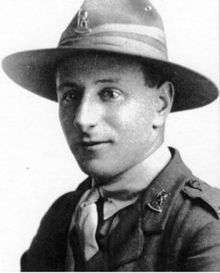Harry Laurent
| Harry Laurent VC | |
|---|---|
 | |
| Born | 15 April 1895 |
| Died | 9 December 1987 (aged 92) |
| Buried at | Servicemen's Cemetery, Hawera |
| Allegiance |
|
| Service/branch |
|
| Rank | Lieutenant Colonel |
| Unit | 2nd Battalion, New Zealand Rifle Brigade |
| Battles/wars |
|
| Awards |
|
Lieutenant Colonel Harry John Laurent VC (15 April 1895 – 9 December 1987) was a New Zealand soldier who served with the New Zealand Military Forces during the First and Second World Wars. He was awarded the Victoria Cross, the highest and most prestigious award for gallantry in the face of the enemy that can be awarded to British and Commonwealth forces, for his actions in the Hundred Days Offensive during the First World War.
Early life
Henry John Laurent, known as Harry, was born on 15 April 1895 in Tarata, in the Taranaki region of New Zealand. After leaving school, he worked as a grocer's assistant. He also served with the Territorial Force, having joined at the age of 16. He enlisted with the New Zealand Expeditionary Force (NZEF) in May 1915, shortly after his 20th birthday.[1]
Military career
Posted to the 2nd Battalion of the New Zealand Rifle Brigade, Laurent served on the Western Front from 1916. He participated in the Somme Offensive during which he was wounded.[2]
By September 1918, Laurent had advanced in rank to sergeant. During the Hundred Days Offensive, the New Zealand Division, following the Second Battle of Bapaume, was in pursuit of retreating German forces. Leading a patrol on 12 September in the area east of Gouzeaucourt Wood, France, Laurent was ordered to locate and regain contact with the German front lines. The 12 man patrol inadvertently penetrated through the frontline and located a line of artillery. Realising the patrol's mistake, Laurent organised a swift attack which resulted in the capture of 112 prisoners, with one member of the patrol being killed and three others wounded. He then extricated his patrol, together with the prisoners, back to the New Zealand line, fighting off counterattacks along the way. For his bravery and leadership, he was awarded the Victoria Cross which was gazetted on 12 November 1918.[1][3]
Laurent later attended an officer training school and was duly commissioned in February 1919. Within a few months, his service in the NZEF ceased and he returned to New Zealand.[2]
Later life

Laurent also served with the New Zealand Military Forces during the Second World War, commanding a battalion in the Home Guard. He retired with the rank of lieutenant colonel.[2] He died in Hastings on 9 December 1987, the last surviving New Zealand VC winner of the First World War. His ashes are interred in the Memorial Wall at the Servicemen's Cemetery at Hawera, in Taranaki. A street in Hawera, his parent's home town, is named after him.[1]
Victoria Cross
Laurent's Victoria Cross was displayed at the QEII Army Memorial Museum, Waiouru, New Zealand. On 2 December 2007 it was one of nine Victoria Crosses that were among a hundred medals stolen from the museum.[4] On 16 February 2008, New Zealand Police announced all the medals had been recovered as a result of a NZ$300,000 reward offered by Michael Ashcroft and Tom Sturgess.[5]
Notes
- 1 2 3 Harper & Richardson 2007, pp. 171–172.
- 1 2 3 McGibbon 2000, p. 274.
- ↑ The London Gazette: no. 31340. p. 6084. 15 May 1919. Retrieved 15 November 2014.
- ↑ Derek Cheng (December 2007). "Army medal theft 'insult' to our nation's heritage". nzherald. Retrieved 2007-12-02.
- ↑ NZPA (February 2008). "Medals stolen from Waiouru Army Museum recovered". nzherald. Retrieved 2012-05-22.
References
- Harper, Glyn; Richardson, Colin (2007). In the Face of the Enemy: The Complete History of the Victoria Cross and New Zealand. Auckland, New Zealand: HarperCollins Publishers (New Zealand) Limited. ISBN 1869506502.
- McGibbon, Ian, ed. (2000). The Oxford Companion to New Zealand Military History. Auckland, New Zealand: Oxford University Press. ISBN 0-19-558376-0.